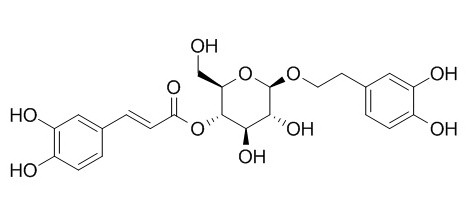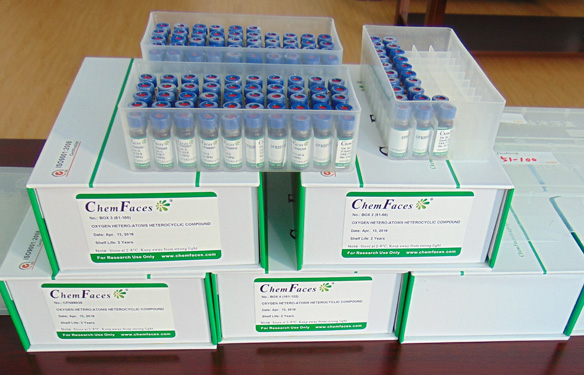Calceolarioside A
Calceolarioside A shows potent activity against visceral leishmaniasis. It can induce a dose-related aggregant effect on rabbit platelets, which may be partly related to a calcium-dependent mechanism. Calceolarioside A also has potent antioxidative activity, it displays stronger scavenging potential with IC50 values of (4.15 +/- 0.07, 40.32 +/- 0.09, 2.26 +/- 0.03 microM) for OH, total ROS and scavenging of ONOO(-), respectively.
Inquire / Order:
manager@chemfaces.com
Technical Inquiries:
service@chemfaces.com
Tel:
+86-27-84237783
Fax:
+86-27-84254680
Address:
1 Building, No. 83, CheCheng Rd., Wuhan Economic and Technological Development Zone, Wuhan, Hubei 430056, PRC
Providing storage is as stated on the product vial and the vial is kept tightly sealed, the product can be stored for up to
24 months(2-8C).
Wherever possible, you should prepare and use solutions on the same day. However, if you need to make up stock solutions in advance, we recommend that you store the solution as aliquots in tightly sealed vials at -20C. Generally, these will be useable for up to two weeks. Before use, and prior to opening the vial we recommend that you allow your product to equilibrate to room temperature for at least 1 hour.
Need more advice on solubility, usage and handling? Please email to: service@chemfaces.com
The packaging of the product may have turned upside down during transportation, resulting in the natural compounds adhering to the neck or cap of the vial. take the vial out of its packaging and gently shake to let the compounds fall to the bottom of the vial. for liquid products, centrifuge at 200-500 RPM to gather the liquid at the bottom of the vial. try to avoid loss or contamination during handling.
J Ethnopharmacol.2016, 194:219-227
Nat Prod Sci.2014, 20(3):182-190
Cell Signal.2024, 124:111467.
Mol Plant Pathol.2023, 24(2):123-141.
Int J Mol Sci.2022, 23(10):5813.
J Chromatogr B Analyt Technol Biomed Life Sci.2019, 1124:323-330
Genes Environ.2024, 46(1):13.
Phytomedicine.2021, 93:153796.
The Korea Journal of Herbology2016, 29-35
J Microbiol Biotechnol.2020, 30(2):178-186.
Related and Featured Products
Planta Med. 1993 Aug;59(4):337-9.
Platelet aggregation induced by calceolarioside A in vitro: role of platelet intracellular calcium.[Pubmed:
8372152]
The effect of Calceolarioside A, a phenylpropanoid glycoside (PhG), isolated from Calceolaria hypericina, was studied on rabbit platelets in vitro.
METHODS AND RESULTS:
Calceolarioside A induced a dose-related aggregant effect on rabbit platelets. Indomethacin did not modify the Calceolarioside A-induced aggregant effect. Furthermore, no modification was exerted by phenoxybenzamine, BW 577C, and WEB 2086 on the PhG aggregant effect. On the contrary, TMB-8, an intracellular calcium blocker, significantly reduced the PhG effect.
CONCLUSIONS:
The latter result suggests that Calceolarioside A aggregation may be partly related to a calcium-dependent mechanism.
J Enzyme Inhib Med Chem. 2009 Aug;24(4):993-7.
Antioxidant phenylpropanoid glycosides from Buddleja davidii.[Pubmed:
19548780]
METHODS AND RESULTS:
Phytochemical investigations on the n-BuOH-soluble fraction of the whole plant of Buddleja davidii led to the isolation of the phenylpropanoid glycosides 1-10. Their structures were determined by 1D and 2D NMR spectroscopic techniques. All the compounds showed potent antioxidative activity in three different tests, with IC(50) values in the range 4.15-9.47 microM in the hydroxyl radical ( OH) inhibitory activity test, 40.32-81.15 microM in the total ROS (reactive oxygen species) inhibitory activity test, and 2.26-7.79 microM in the peroxynitrite (ONOO(-)) scavenging activity test.
CONCLUSIONS:
Calceolarioside A (1) displayed the strongest scavenging potential with IC(50) values of (4.15 +/- 0.07, 40.32 +/- 0.09, 2.26 +/- 0.03 microM) for OH, total ROS and scavenging of ONOO(-), respectively.
Planta Med. 2008 Apr;74(5):503-8.
In vivo efficacy of calceolarioside A against experimental visceral leishmaniasis.[Pubmed:
18543147]
METHODS AND RESULTS:
Bioactivity-guided fractionation has led to the successful isolation of Calceolarioside A ( 1) from the methanolic extract of night jasmine leaves. The in vitro antileishmanial activity of Calceolarioside A was determined (IC (50) = 20 microg/mL). Its IN VIVO efficacy was noted at 20 mg/kg body weight when it reduced the hepatic and splenic parasite burden by 79 and 84 %, respectively, in an established model of L. donovani Ag83 infected golden hamster. Furthermore, synergistic potentiations of Calceolarioside A at 20 mg/kg body weight and SAG at 5 mg/kg body weight showed a significant reduction of hepatic and splenic parasite burden. No cytotoxicity was observed against the U937 cell line.
CONCLUSIONS:
This is the first report describing the isolation of Calceolarioside A from N. arbor-tristis L. and the first demonstration of its potent activity against visceral leishmaniasis.



